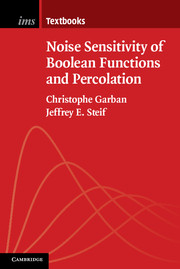Book contents
- Frontmatter
- Dedication
- Contents
- Preface
- Notations
- 1 Boolean functions and key concepts
- 2 Percolation in a nutshell
- 3 Sharp thresholds and the critical point for 2-d percolation
- 4 Fourier analysis of Boolean functions (first facts)
- 5 Hypercontractivity and its applications
- 6 First evidence of noise sensitivity of percolation
- 7 Anomalous fluctuations
- 8 Randomized algorithms and noise sensitivity
- 9 The spectral sample
- 10 Sharp noise sensitivity of percolation
- 11 Applications to dynamical percolation
- 12 For the connoisseur
- 13 Further directions and open problems
- References
- Index
11 - Applications to dynamical percolation
Published online by Cambridge University Press: 18 December 2014
- Frontmatter
- Dedication
- Contents
- Preface
- Notations
- 1 Boolean functions and key concepts
- 2 Percolation in a nutshell
- 3 Sharp thresholds and the critical point for 2-d percolation
- 4 Fourier analysis of Boolean functions (first facts)
- 5 Hypercontractivity and its applications
- 6 First evidence of noise sensitivity of percolation
- 7 Anomalous fluctuations
- 8 Randomized algorithms and noise sensitivity
- 9 The spectral sample
- 10 Sharp noise sensitivity of percolation
- 11 Applications to dynamical percolation
- 12 For the connoisseur
- 13 Further directions and open problems
- References
- Index
Summary
In this section, we present a very natural model where percolation undergoes a time-evolution: this is the model of dynamical percolation described below. The study of the “dynamical” behavior of percolation as opposed to its “static” behavior turns out to be very rich: interesting phenomena arise especially at the phase transition point. We will see that in some sense, dynamical planar percolation at criticality is a very unstable or chaotic process. In order to understand this instability, sensitivity of percolation (and therefore its Fourier analysis) will play a key role. In fact, the original motivation for the paper (BKS99) on noise sensitivity was to solve a particular problem in the subject of dynamical percolation. (Ste09) provides a recent survey on the subject of dynamical percolation.
We mention that one can read all but the last section of the present chapter without having read Chapter 10.
The model of dynamical percolation
This model was introduced by Häaggströom, Peres, and Steif (HPS97) inspired by a question that Paul Malliavin asked at a lecture at the Mittag-Leffler Institute in 1995. This model was invented independently by Itai Benjamini.
In the general version of this model as it was introduced, given an arbitrary graph G and a parameter p, the edges of G switch back and forth according to independent two-state continuous time Markov chains where closed switches to open at rate p and open switches to closed at rate 1 − p. Clearly, the product measure with density p, denoted by πp in this chapter, is the unique stationary distribution for this Markov process. The general question studied in dynamical percolation is whether, when we start with the stationary distribution πp, there exist atypical times at which the percolation structure looks markedly different than that at a fixed time.
- Type
- Chapter
- Information
- Noise Sensitivity of Boolean Functions and Percolation , pp. 132 - 143Publisher: Cambridge University PressPrint publication year: 2014



